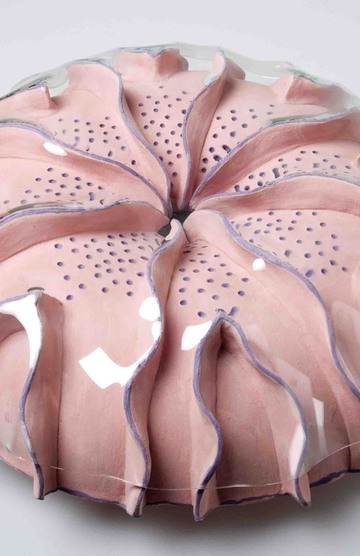Production and decoration
Manufacturing kinrande porcelain was a costly and labour-intensive process. Because the porcelain was decorated with enamel colours, it had to be fired several times. Then a decoration with gold leaf was applied and polished. This gold decoration is very sensitive to wear and tear, which is why it is missing from many kinrande objects today. This new acquisition is decorated using this technique and the gold decoration is still beautifully preserved. All four sides and the cover are decorated with different scenes of people in a landscape, surrounded by geometric patterns and prunus blossoms. The splashes of green enamel are a charming detail. The base has the character 天 (tian), meaning ‘sky’.
This tiered box is an example of the technical proficiency of Chinese potters. Producing objects with straight walls is much more complex than objects with round walls because they collapse more easily. In addition, assembling the various parts is a difficult job, due to the shrinkage of the clay during the several firing stages, and the complicated gold-leaf decorative technique is very time-consuming.
Flexible
The kinrande tiered box exemplifies how Chinese production was easily adapted to the tastes and requirements of foreign markets, such as those in Japan. The same happened for other markets, for example, those in West Asia and Southeast Asia. At the time that this tiered box was produced, Japan was not yet able to make its own porcelain objects. So while it was not only fashionable to use Chinese products, in the case of porcelain, they had to be imported anyway.
These earlier examples of catering to a taste not one’s own are precursors to the explosive growth of chine de commande (commissioned) objects ordered by European trading companies like the Dutch East India Company from the 17th century onwards.
Exhibition
In recent years, the Princessehof has been committed to highlighting under-represented stories in the museum. Recent examples in which this acquisition policy has been successfully applied at Princessehof include the purchase of the 19th-century Wedgwood antislavery medallion and an 18th-century cup and saucer produced in Meissen. Like these acquisitions, the kinrande box will occupy a central place in the museum’s permanent exhibition; furthermore it is a valuable addition to the primarily Eurocentric perspective, as it sheds light on the story of inter-Asian production, trade relations and cultural exchanges. Objects illustrating the inter-Asian exchange are in short supply in the Netherlands. This new acquisition by the Princessehof is therefore also a valuable addition to the national Netherlands Collection.
Support
The Princessehof’s collection is largely reliant on donations and legacies. Without external support, purchases like this would not be possible, and we greatly appreciate our partners’ generosity and commitment. The acquisition of the Chinese tiered kinrande box was made possible with support from the Mondriaan Fund and the Princessehof’s two friend associations: the Friends of the Princessehof, who supported the purchase to mark their 50th anniversary, and Club Céramique.
Partners of the Princessehof: Ottema-Kingma Foundation, Association of Friends of the Princessehof Ceramics Museum and Club Céramique.
Princessehof Ceramics Museum is co-funded by the Ministry of Education, Culture and Science and the Municipality of Leeuwarden
2.jpg?width=600&height=387&mode=crop&converttowebp=1)




%2c%201500-1600%2c%20Collectie%20Keramiekmuseum%20Princessehof.%20(c)%20Jorge%20Welsh.jpg?width=600&height=371&mode=crop&converttowebp=1)
%2c%201500-1600%2c%20Collectie%20Keramiekmuseum%20Princessehof.%20(c)%20Jorge%20Welsh%20(4).jpg?width=600&height=371&mode=crop&converttowebp=1)